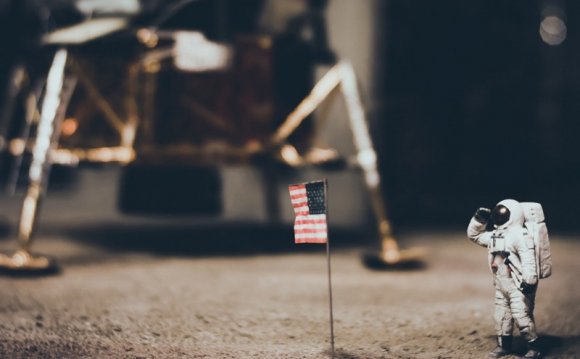
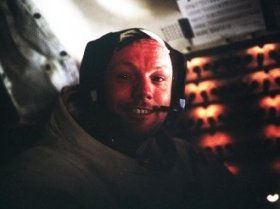 Astronaut Neil A. Armstrong, Apollo 11 Commander, inside the Lunar Module as it rests on the lunar surface after completion of his historic moonwalk in July 1969.
Astronaut Neil A. Armstrong, Apollo 11 Commander, inside the Lunar Module as it rests on the lunar surface after completion of his historic moonwalk in July 1969.
Only a handful of men have stood on the moon and looked up at Earth. NASA landed six missions and 12 astronauts on the moon during the Apollo program. Six others remained in lunar orbit aboard their Apollo spacecraft command modules. One mission, Apollo 13, was aborted in mid-flight. Here is a snapshot of NASA's six successful moon-landing crews and where they are now:
Apollo 11
Neil Armstrong: Commander, Apollo 11, the first manned moon landing flight, which landed on the lunar surface on July 20, 1969. Armstrong was a Navy aviator and later a test pilot for NASA's precursor agency, the National Advisory Committee for Aeronautics, where he tested the X-15 rocket plane, among other experimental aircraft. He joined NASA in 1962 and commanded the Gemini 8 mission in 1966 to perform the first space docking in orbit. Armstrong left NASA in 1971 to teach aerospace engineering at the University of Cincinnati and chair an electronic systems company. Armstrong died Aug. 25, 2012, of complications related to recent surgery at age 82. [Photos: Neil Armstrong — American Icon Remembered]
Buzz Aldrin: Lunar module pilot, Apollo 11. A U.S Air Force pilot before joining NASA in 1963, Aldrin first launched into space on the Gemini 12 mission in 1966 to test spacewalking procedures, including new restraints attached to the outside of the space capsule, and new training techniques. After becoming the second man to walk on the moon, Aldrin resigned from NASA in July 1971. Post-NASA, he has written numerous books, given lectures around the world, and even participated in the reality television show "Dancing With the Stars." Aldrin is currently the president of Starcraft Enterprise, a company he founded to promote his vision for the future of space exploration.
Michael Collins: Command module pilot, Apollo 11. Collins stayed on the Columbia command module while Armstrong and Aldrin took the Eagle lunar lander down to the moon's surface. Apollo 11 was Collins' second spaceflight, after the Gemini 10 mission in 1966. On that flight, Collins served as pilot during a successful rendezvous and docking with a separately launched unmanned spacecraft called Agena. Before joining NASA in 1963, Collins was an experimental flight test officer in the U.S. Air Force, logging approximately 5, 000 hours flying time. He retired as a brigadier general from the Air Force, and left NASA in 1970 to work for the U.S. State Department, and then to become the director of the Smithsonian's National Air & Space Museum. In 1980, Collins left the Smithsonian, joining the LTV Aerospace company, and then started his own consulting firm in 1985. He has written several books and paints watercolors.
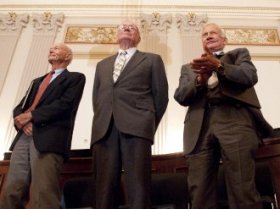 Apollo 11 astronauts, from left, Michael Collins, Neil Armstrong and Buzz Aldrin stand during a recognition ceremony at the U.S House of Representatives Committee on Science and Technology tribute to the Apollo 11 astronauts at the Cannon House Office Building on Capitol Hill, Tuesday, July 21, 2009, in Washington. The committee presented the three Apollo 11 astronauts with a framed copy of House Resolution 607 honoring their achievement, and announced passage of legislation awarding them and John Glenn the Congressional Gold Medal.
Apollo 11 astronauts, from left, Michael Collins, Neil Armstrong and Buzz Aldrin stand during a recognition ceremony at the U.S House of Representatives Committee on Science and Technology tribute to the Apollo 11 astronauts at the Cannon House Office Building on Capitol Hill, Tuesday, July 21, 2009, in Washington. The committee presented the three Apollo 11 astronauts with a framed copy of House Resolution 607 honoring their achievement, and announced passage of legislation awarding them and John Glenn the Congressional Gold Medal.
Apollo 12
Charles "Pete" Conrad: Commander, Apollo 12. Conrad headed up the second lunar landing mission, Apollo 12, in November 1969. Conrad became the third person to walk on the moon, and spent more than a day exploring the lunar surface. Apollo 12 was Conrad's third spaceflight, following his turns on the Gemini 5 and Gemini 11 missions. A test pilot for the U.S. Navy, Conrad joined NASA in 1962, and retired in 1973 after commanding the Skylab 2 mission on the first American space station. After his military and NASA career, Conrad worked at the American Television and Communications Corporation (ATC) and the McDonnell Douglas Corporation. He died in 1999, following a motorcycle accident in Ojai, Calif.
Alan Bean: Lunar module pilot, Apollo 12. Bean's first spaceflight was Apollo 12, during which he spent more than a day on the surface of the moon with Pete Conrad. A captain the U.S. Navy, Bean joined NASA in 1963, and followed up Apollo 12 as commander of the Skylab 3 mission in 1973. He retired from NASA in 1981 to concentrate on painting, saying he was inspired to communicate his space experiences through art. In 2009, to celebrate the 40th anniversary of the first moon landing, many of Bean's works were displayed at the Smithsonian National Air and Space Museum in Washington, D.C.
Richard F. "Dick" Gordon: Command module pilot, Apollo 12. On Apollo 12, Gordon stayed inside the command module Yankee Clipper, photographing potential future lunar landing sites while Conrad and Bean walked on the moon. Gordon, a captain in the U.S. Navy, was selected as an astronaut in 1963, and served as pilot for the Gemini 11 mission in September 1966. He retired from NASA and the Navy in 1972, and went on to work for the New Orleans Saints Professional Football Club; Energy Developers, Limited (EDL); Resolution Engineering and Development Company (REDCO); and Astro Sciences Corporation. [NASA's 17 Apollo Moon Missions in Pictures]
Apollo 14
Alan Shepard: Commander, Apollo 14. Prior to commanding Apollo 14 in 1971, Shepard became the first American to reach space when he rode in the Freedom 7 spacecraft on May 5, 1961, under NASA's Mercury program. Apollo 14 marked his second spaceflight, following a stint as chief of NASA's astronaut office, a job he resumed after his moon mission. During his walk on the moon, he famously hit two golf balls and watched them soar in the low lunar gravity. Shepard, a rear admiral of the U.S. Navy, left NASA and the Navy in 1974. After NASA, Shepard wrote a book about his space experiences, served on the boards of various corporations, and helped lead the Mercury Seven Foundation, which awarded college scholarships for science. He died in 1998 of leukemia. [Photos: Freedom 7, America's First Manned Spaceflight]
Edgar Mitchell: Lunar module pilot, Apollo 14. Mitchell's first flight to space on Apollo 14 sent him to the moon with Alan Shepard for a total of 216 hours and 42 minutes in space. The U.S. Navy captain retired from NASA and the Navy after that mission in 1972, going on to found the Institute of Noetic Sciences, dedicated to the study of consciousness. He has written books on mystical experiences and psychic exploration.
RELATED VIDEO
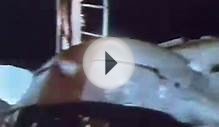

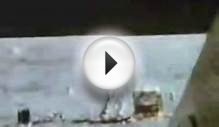

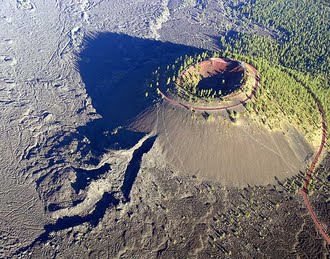 Lava Butte is a cinder cone located in central Oregon, USA, just west of US Highway 97 between the towns of Bend, Oregon, and Sunriver, Oregon. It is part of a system of small cinder cones on the northwest flank of Newberry Volcano, a massive shield volcano which...
Lava Butte is a cinder cone located in central Oregon, USA, just west of US Highway 97 between the towns of Bend, Oregon, and Sunriver, Oregon. It is part of a system of small cinder cones on the northwest flank of Newberry Volcano, a massive shield volcano which...
 The Hollywood Walk of Fame consists of more than 2,400 five-pointed terrazzo and brass stars embedded in the sidewalks along fifteen blocks of Hollywood Boulevard and three blocks of Vine Street in Hollywood, California. The stars are permanent public monuments to...
The Hollywood Walk of Fame consists of more than 2,400 five-pointed terrazzo and brass stars embedded in the sidewalks along fifteen blocks of Hollywood Boulevard and three blocks of Vine Street in Hollywood, California. The stars are permanent public monuments to...
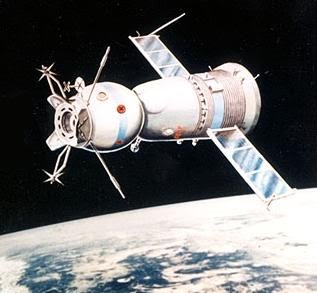 The Soyuz programme (Russian: Союз, pronounced [sɐˈjus], meaning "Union") is a human spaceflight programme that was initiated by the Soviet Union in the early 1960s, originally part of a Moon landing project intended to put a Soviet cosmonaut on the Moon. It was the...
The Soyuz programme (Russian: Союз, pronounced [sɐˈjus], meaning "Union") is a human spaceflight programme that was initiated by the Soviet Union in the early 1960s, originally part of a Moon landing project intended to put a Soviet cosmonaut on the Moon. It was the...








